Physicochemical and Functional Properties of Starches from Pachyrhizus erosus with Low Digestibility
- DOI
- 10.2991/efood.k.210626.001How to use a DOI?
- Keywords
- Pachyrhizus erosus; starch; physicochemical properties; rheological properties; in vitro digestion
- Abstract
The search for novel natural ingredients has been stimulated by the food and non-food industries, and roots of Pachyrhizus erosus (jicama) emerges as promising crops for industrial production due to its crispy and succulent flesh and high yield. Therefore, jicama starches from Fujian Province (SFJ) and Guangxi Province (SGX) were isolated and the microstructure, swelling power, crystallinity, thermal property, rheological property, and in vitro digestibility were determined. The starch granules of SFJ and SGX showed polyhedral, spherical or semi-spherical shapes with smooth nonporous surface. SFJ and SGX showed increasing solubility and swelling power with the increasing of temperature. By X-ray diffraction analysis, both had typical A-type crystallinity, but SFJ showed lower relative crystallinity (29.4%) than SGX (35.4%). SFJ with smaller granule sizes and lower relative crystallinity showed weaker thermal stability, lower viscosity, weaker strength of starch gels, and lower Resistant Starch (RS) content. The high contents of RS in SFJ (65.67%) and SGX (70.37%) suggested that jicama is promising low energy food for special purposes.
- HIGHLIGHTS
- •
Jicama starches [Sample from Fujian Province (SFJ) and Sample from Guangxi Province (SGX)] were isolated and characterized by various techniques.
- •
SFJ and SGX showed similar shapes with smooth and nonporous surface.
- •
SFJ had smaller granule sizes and lower relative crystallinity.
- •
SFJ gels possessed weaker thermal stability, lower viscosity, and weaker strength.
- •
SGX had lower resistant starch content by in vitro digestion experiment.
- •
- Copyright
- © 2021 The Authors. Publishing services by Atlantis Press International B.V.
- Open Access
- This is an open access article distributed under the CC BY-NC 4.0 license (http://creativecommons.org/licenses/by-nc/4.0/).
1. INTRODUCTION
Starch is a kind of natural, renewable, and degradable carbohydrate, severing as basic metabolic energy provider. Different parts of plants, including seeds, roots, as well as stems, leaves, fruits and even pollens are common sources of starches [1,2]. Modern research on starches from various resources have demonstrated wide applications in food, plastic, adhesive, daily necessities, and pharmaceutical industries due to their distinguished gelling, film forming, and biodegradable properties [3–5]. Generally, starch is classified into Rapidly Digestible Starch (RDS), Slowly Digestible Starch (SDS), and Resistant Starch (RS) according to the rate of digestibility in the human body. Specifically, RDS is rapidly digested in the mouth and small intestine, and SDS is completely digested in the small intestine at a comparatively slow rate, while RS is used by microorganisms in the large intestine [6]. The digestibility properties of starch can reflect the nutritional values of food. At present, the major resources of starches in commercial market are maize, cassava, potato, wheat, and rice, which have relatively low contents of RS [7]. With the growing market and industrial demands, exploration of new starches with different physicochemical, structural, and functional properties has been greatly motivated [8–10].
Pachyrhizus erosus root, also called jicama or yam bean, is a kind of vegetable with crispy and succulent flesh in white or light brown color. It can be eaten both in raw slices and cooked forms. This tropical/subtropical plant in legume family has been cultivated in Mexico since early times, and then being extensively imported to many other countries. It has high productivity and special sensory attributes, but it is underutilized at present [11]. A recent review reported that this un-exploited crop has potential applications in food industry, such as production of monosaccharides, oligosaccharides, high glucose syrups, flour, and wine, and being incorporated in yogurt or other milk products [12]. The tuberous jicama root contains about 80% water, 0.1% lipid, 0.5% ash, 1% protein, 15% carbohydrates, and 9% starch [13]. As a major component of the root, starch has been characterized in many studies [14–17]. Those starches from Pachyrhizus spp. were found to have small circular and polygonal shapes, and low pasting temperature [12]. At present, there are only a few investigations referring to the physicochemical and functional properties of jicama starches isolated that are widely cultivated in China. Since planting time and development stages has ever been found to influence the starch characteristics [18], it is reasonable to speculate that other cultivation conditions such as soil and cultivar may also play important roles. Thus, scientific data of starch from P. erosus cultivated in different regions in China are required to develop novel starch resources and improve the utilization value of this high-yield crop. Moreover, the digestibility or nutritional properties of jicama starches has not yet been clearly studied. Therefore, we isolated starches from jicama harvested in Fujian and Guangxi province. The microstructure, swelling power, thermal property, crystallinity, rheological property and in vitro digestibility were determined and compared. Our research may provide guidance for utilization of P. erosus and develop novel starch resources into the commercial markets.
2. MATERIALS AND METHODS
2.1. Materials
Fresh tubers of P. erosus were purchased from local markets in Fuzhou city (Fujian province, China) and Nanning city (Guangxi province, China), respectively. They were received at laboratory and processed immediately with wounded and unhealthy roots being discarded. Amyloglucosidase (70 U/mg) from Aspergillus niger amyloglucosidase and pancreatic α-amylase (50 U/mg) were purchased from Sigma-Aldrich Inc. (St. Louis, MO, USA). All other chemicals and reagents were of analytical grade unless otherwise stated.
2.2. Extraction of Jicama Starch
The starch was isolated from the raw materials referring to a previous procedure [15]. Briefly, fresh roots were washed, peeled, chopped, and squeezed with distilled water. The mixture was drained with a #200 mesh and the obtained solution was kept at 4°C for 12 h to precipitate the starch. The supernatant was removed by centrifugation (4800 rpm, 10 min), and the precipitate was washed thoroughly with anhydrous ethanol and distilled water for several times to remove some contaminated compounds. The white powders after freeze-drying were named as SFJ and SGX.
2.3. Structure Characterization
2.3.1. Optical microscopy
The morphology of SFJ and SGX was first evaluated by optical microscope (OM) (Olypus DP73, Shinjuku, Tokyo, Japan). The starch sample was placed on a tube and mixed with 1–2 drops of water. A drop of the starch slurry was transferred onto the slide and then covered with a glass cover slip and the granule morphology was observed at 20× magnifications.
2.3.2. Scanning electron microscopy (SEM)
For the Scanning Electron Microscopy (SEM) observation, a FEI Nova NanoSEM system at high vacuum was used. The samples were fixed on an aluminum specimen holder with double graphite tape and then sputter-coated with gold particles. The measurement was done using a 5 kV electron acceleration voltage. Diameters of starch granules were measured based on at least 30 starch granules on SEM micrographs (5000×).
2.3.3. Particle size distribution
The size distribution of jicama starch granules was measured using a laser light scattering-based particle size analyzer (Malvern Instruments, Malvern, UK) according to the instructions supplied with the instrument. The starch was evenly dispersed in absolute ethanol at a concentration of 0.1% (w/v) with magnetic agitation and sonication before test.
2.3.4. Fourier transform infrared spectroscopy (FT-IR)
Functional groups of the samples were determined by using a Nicolet 380 FT-IR spectrometer (Thermo Scientific, USA) within a range of wavenumbers from 4000 to 400 cm−1.
2.3.5. Crystallinity of starch
X-ray Diffraction (XRD) of starch was conducted using Empyrean PANalytical diffractometer (Netherlands) according to a modified method [19]. Prior to XRD analysis, the samples were freeze-dried and milled to pass through a 200-mesh sieve. The scan was performed at 30 kV and 10 mA for a 2θ range of 5–35° with a step size of 0.01. The relative crystallinity was calculated according to the report of Wang and Liu [20].
2.4. Physicochemical Properties
2.4.1. Swelling power and solubility
The starch sample (0.2 g) was finely dispersed into 10 mL distilled water and then the mixture was heated at 55, 65, 75, 85, and 95°C in a water bath for 60 min. After heating, the samples were centrifuged at 3000 rpm for 10 min (TDL-5-A, Shanghai Anting, China). The supernatant was dried at 105°C, and the precipitate was weighed directly. The swelling power and solubility were calculated according to method reported by Karunaratne and Zhu [21].
2.4.2. Transparency of starch pastes
The transparency of starch pastes were measured using the previous method with a slight modification [22]. Briefly, the starch pastes were prepared as follows: an appropriate amount of starch was suspended in water to obtain a final 1% (w/w) suspension. Each sample was cultivated in a water bath at 95 ± 1°C for 20 min. During the heating process, the samples were refilled with water to replenish water loss due to evaporation, and starch paste was transferred to disposable spectrophotometric cuvettes. The measurements were performed at 5, 10, 30, and 60 min using a UV 1100 spectrophotometer (MAPADA Instruments, Shanghai, China) at a wavelength of 600 nm using water as control.
2.4.3. Gelatinization properties
Gelatinization properties were analyzed according to a published method with some modifications [23]. The onset temperature (To), peak temperature (Tp), conclusion temperature (Tc), and gelatinization enthalpy (ΔHg) of SFJ and SGX were monitored by Differential Scanning Calorimetry (DSC 214 Polyma, NETZSCH-Gerätebau GmbH, Germany). In detail, accurately weighed sample was immersed in a 3:1 of liquid–solid ratio of deionized water. A drop of the mixed products was weighed into an aluminum pan and sealed quickly. It was equilibrated for 24 h at 4°C and then heated from 30 to 100°C at 10°C min−1. The parameters (To, Tp, Tc, and ΔHg) were obtained from the DSC thermogram.
2.4.4. Rheological properties
The rheological properties of the starch samples were studied using a stress-controlled rheometer (MCR 302, Anton Paar, Austria) equipped with a 50 mm diameter parallel plate. A gap of 0.60 mm was used to perform all the rheological tests at 25°C.
2.4.5. Steady shear test
Starch pastes at 1–5% (dry weight basis) of total solids were prepared by heating the starch dispersions in boiling water bath for 30 min. Samples were equilibrated for about 2 min before test. In the shear rate sweep mode, the pastes were sheared from 0.1 to 1000 s−1 to describe the flow behavior.
2.4.6. Dynamic oscillatory measurements
A strain sweep measurement was performed at a constant frequency of 10 rad s−1 from 0.01% to 100% to determine the linear viscoelastic region. The dependence of loss modulus (G″) and storage modulus (G′) on frequency were measured in frequency sweep mode. The strain was 2% and angular frequency from 1 to 100 rad s−1. The tests were done in the linear viscoelastic region. The creep experiment was conducted at constant stress of 0.8 Pa, which was instantly applied and maintained for the duration of 180 s. The creep compliance was calculated as the ratio of the total strain at a given time to the constant stress [24].
2.5. In vitro Digestibility
The in vitro digestibility of SGX and SFJ was determined according to the methods of Englyst with some modifications [25,26]. Accurately, 200 mg of starch samples were suspended in 15 mL of 0.2M sodium acetate buffer (pH 5.2) in 50 mL centrifuge tubes. Then, 5 mL of enzyme mixtures containing porcine pancreatic α-amylase (300 U mL−1) and amyloglucosidase (20 U mL−1), which were dissolved in 0.2M sodium acetate buffer (pH 5.2), were added into the starch suspension. The mixture was incubated at 37°C with stirring at 200 rpm in a water bath. Aliquots (0.5 mL) of the hydrolysate were withdrawn at 20, 40, 60, 80, 100, and 120 min and mixed with 0.5 mL of absolute ethanol to inactivate enzymes. After centrifuging at 3000 rpm for 10 min, the glucose contents of the hydrolysates were detected by a 3,5-dinitrosalicylic acid method. The glucose content (Gt) at intervals of different times were labeled as G20, G40, G60, G80, G100, and G120, respectively. Specifically, the hydrolysis rate (%), RDS, SDS, and RS contents were calculated as follows:
3. RESULTS AND DISCUSSION
3.1. Structure Characterization of Starch
3.1.1. Morphology and particle size of starch granules
As described above, fresh tuber of P. erosus was subjected to washing, slicing, and squeezing, and precipitating. Two kinds of starch samples (SFJ and SGX) were recovered from Fujian and Guangxi province, respectively. The yields of SFJ and SGX by three repeating experiments were 2.20 ± 0.01% and 1.09 ± 0.10%, respectively. The starch morphology is considered important due to its relationship with amylose content, water absorption capability, and solubility. Figure 1 shows the micrograph of detected starches. In Figure 1a and 1b, the starches granules of SFJ and SGX observed by OM showed polyhedral, spherical or semi-spherical shapes with different sizes. More clearly, SEM images (Figure 1c and 1d) shows that those starch granules performed smooth and nonporous surface. By measuring the sizes of at least 30 unbroken particles in Figure 1c and 1d, the diameters of particles of SFJ and SGX varied from 3 to 9 µm, indicating that jicama starches belong to B-type starch according to the previous reports [27,28]. Averagely, SFJ (5.2 ± 1.5 μm) had more granules in smaller size than SGX (5.4 ± 1.6 μm). This result was close to the granule sizes determined by laser light scattering particle size analyzer, which was 3.16 ± 1.40 μm for SFJ and 4.41 ± 1.66 μm for SGX. The morphology of starch observed in our study was consistent with that of starch from isolated Jicama grown in Mexico [15]. The starches also had similar shape with granules of maize starches [24], and their sizes were similar with those of young bamboo culm starches [29].
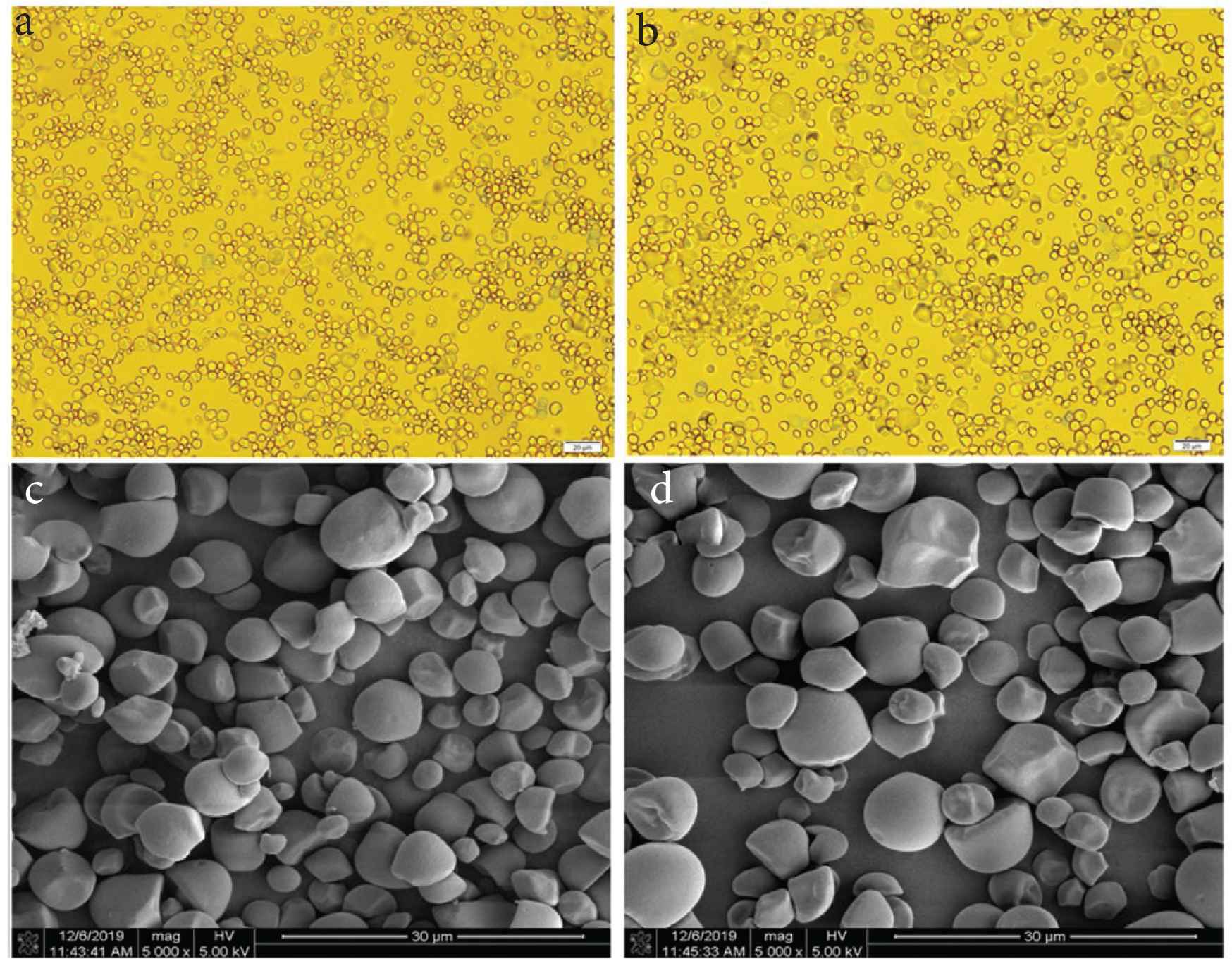
Micrographs of starch granules isolated from P. erosus cultivated in Fujian province (SFJ) and Guangxi province (SGX), respectively. (a) SFJ observed in optical microscope at 20×; (b) SGX observed in optical microscope at 20×; (c) SFJ observed in Scanning Electron Microscope (SEM) at 5000×; (d) SGX observed in SEM at 5000×.
3.1.2. FT-IR spectra of SFJ and SGX
The FT-IR spectra of SFJ and SGX are presented in Figure 2 with the labeled wavenumbers of the main peaks. The two samples possessed similar chemical structure according to the FT-IR spectra. In detail, the absorption bands at around 3300–3600, ~2900, ~1150 (700–900), and 1000–1100 (1648) cm−1 in the spectra indicated the presence of OH, C–H, C–O–C, and C–O functional groups, respectively [30,31]. Furthermore, a group of absorbance peaks at around 1300–1500 cm−1 showed the existence of C–H in –CH2OH moiety. The uncommon peak at 2362 cm−1 was probably derived from CO2 in the air. The above data of SFJ and SGX were consistent with that of corn, cassava, and potato starches [30].
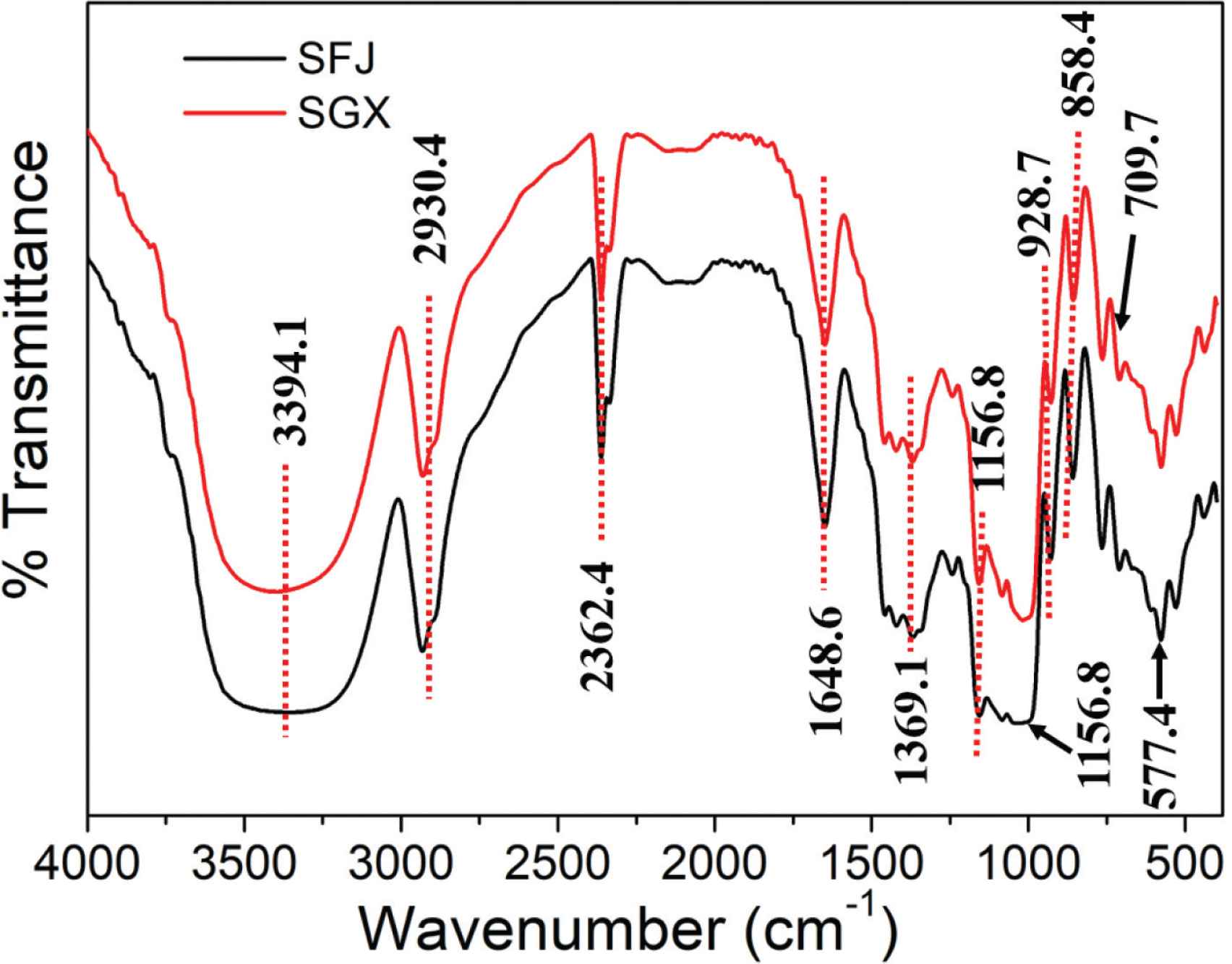
FT-IR spectroscopy of starches granules respectively isolated from P. erosus cultivated in Fujian province (SFJ) and Guangxi province (SGX).
3.1.3. Relative crystallinity by XRD analysis
The crystallinity of starch is a key index of starch, which is jointly determined by many factors, such as the amylopectin content, chain length, and distribution of amylopectin, crystal size, the orientation and extent of interaction between double helices [32]. According to the XRD patterns in Figure 3a, starch granules of SFJ and SGX showed strong diffraction peaks at 15°, 17°, 18°, and 23° (Figure 3d), belonging to a typical A-type crystallinity. SFJ showed lower relative crystallinity (29.4%) than SGX (35.4%), indicating that SGX had higher thermal stability due to the fact that higher degree of crystallinity results in higher gelatinization temperature [30].
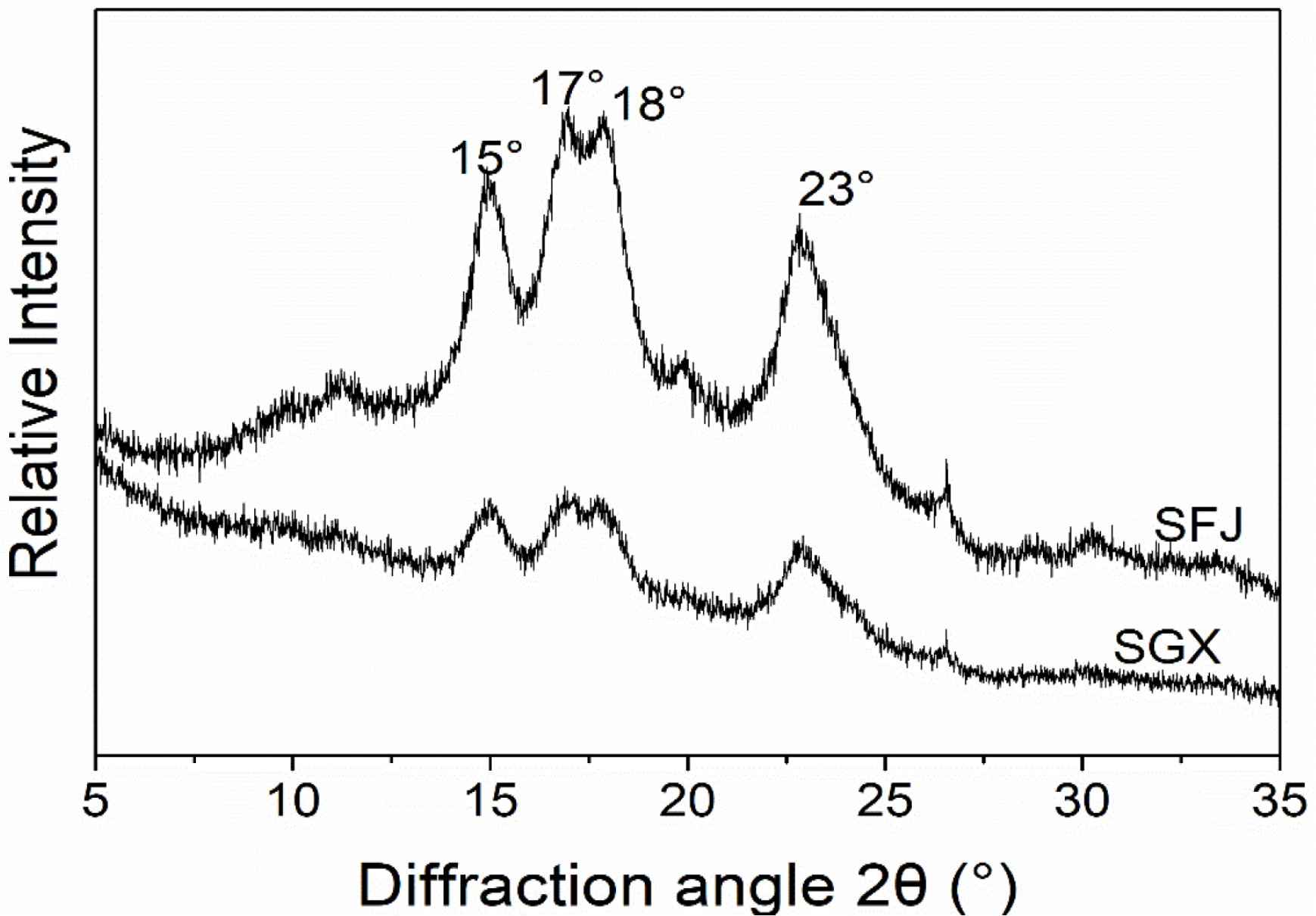
XRD curves of starches from P. erosus cultivated in Fujian (SFJ) and Guangxi (SGX).
3.2. Physicochemical Properties of SFJ and SGX
3.2.1. Swelling power, solubility, and transparency
Swelling power of starch reflects its hydration ability, during which the expansion of starch granules can promote the attack of the internal structure by digestive enzymes, resulting in increasing rate of starch hydrolysis. Figure 4a and 4b shows the swelling power and solubility of SFJ and SGX at various temperatures. Obviously, the starch particles swelled to only a small extent at 55–65°C; however, they expended quickly when the temperature was increased to 65–95°C. The swelling pattern in our investigation were similar with those of sweet potato starch [33], but different from those of corn starches reported before [31]. The decreasing trend of swelling of SFJ at 95°C may be due to the increasing activity of α-amylase at high temperature or the leaching out of cloudy solids caused by heating [33]. Though the swelling power and solubility of SFJ and SGX had similar increasing trend with the temperature ramping from 55 to 95°C, there were some differences between the two starch samples. Firstly, at lower temperature (55–75°C), the solubility of SFJ was a little higher than that of SGX, which may be attributed to the smaller size of its granules [34]. Secondly, SGX hold stronger swelling power than SFJ at 95°C; however, it showed lower solubility.
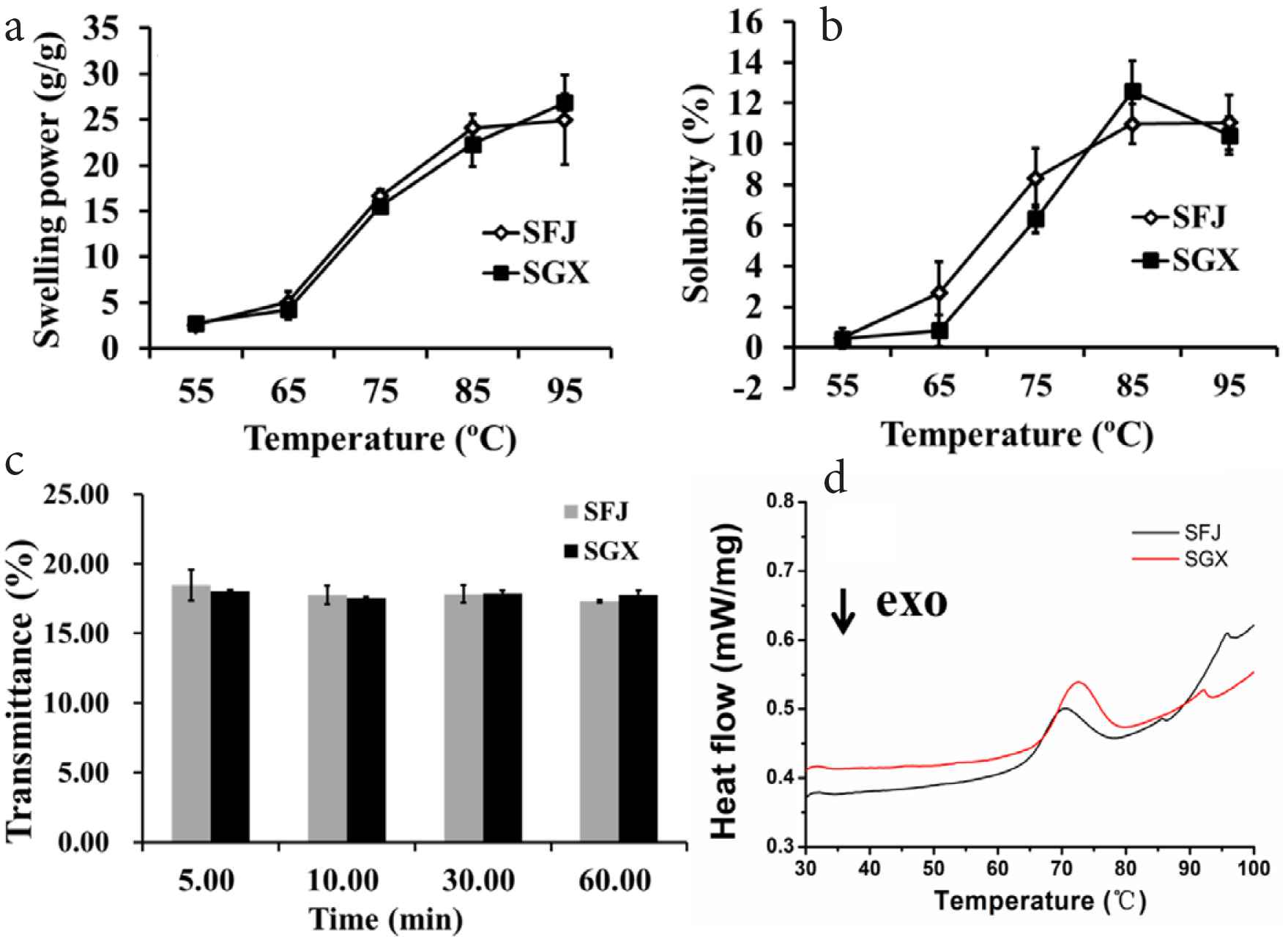
Swelling power (a), solubility (b), transparency (c), and DSC curves (d) of starches from P. erosus cultivated in Fujian (SFJ) and Guangxi (SGX).
Transparency provides information of the behavior of starch paste when the light passes through it. Its value depends on granule size, swelling capabilities, amylose content, and amylose/amylopectin ratio. The transparency of 1% (m/v) starch pastes in Figure 4c was about 18% and showed no big change in 60 min. The value was close to that of chestnut starch but much lower than the transparency value of potato starch [35].
3.2.2. Thermal property by DSC
Thermal property related crucial parameters (To, Tp, Tc, and ΔHg) derived from DSC diagram (Figure 4d) were summarized in Table 1. The SFJ showed lower gelatinization temperatures than SGX, which could be attributed to its relatively smaller starch granules and lower crystallinity [30]. According to Abdullah et al., the gelatinization temperature is a key parameter in the bioplastic production. If it is lower than 60°C, the starch slurry might be gelatinized in the drying process; if too high, the production process causes high energy cost [30]. Therefore, the starch from P. erosus may be potential to be used in the bioplastic production.
| Samples | SFJ | SGX |
|---|---|---|
| DSC parameters of gelatinization | ||
| To(°C) | 61.7 ± 0.1 | 65.2 ± 0.5 |
| Tp(°C) | 70.7 ± 0.1 | 73.3 ± 0.5 |
| Tc(°C) | 79.3 ± 0.0 | 80.5 ± 0.6 |
| ΔHg (J g−1) | 3.1 ± 0.2 | 2.9 ± 0.3 |
| Contents of RDS, SDS, and RS | ||
| RDS (%) | 16.22 ± 0.49 | 11.42 ± 0.62 |
| SDS (%) | 18.45 ± 0.98 | 18.02 ± 1.14 |
| RS (%) | 65.67 ± 0.88 | 70.37 ± 1.82 |
DSC parameters and contents of RDS, SDS, and RS of starches from P. erosus cultivated in Fujian (SFJ) and Guangxi (SGX)
The ΔHg in our test is around 3.0 J g−1, which is greatly lower than the values of common starches from various sources, such as potato, Tapioca, waxy corn, sweet potato [33], but close to the data of starches from young bamboo culm of Dendrocalamus asper [29]. Given that sample with more B-type starch granules are associated with low ΔHg and relative crystallinity, the low ΔHg of starch from P. erosus may be related to their B-type starch granules [34].
3.3. Rheological Properties
3.3.1. Steady shear rheological properties
The viscosity curves of SFJ and SGX gels from 1% (w/v) to 5% (w/v) by steady shear experiment at 25°C were in Figure 5a and 5b, respectively. The apparent viscosities of SFJ and SGX gels presented shear-thinning behaviors, which belonged to the typical pseudo-plastic fluids. The comparative curves of SFJ and SGX at 5% (w/v) in Figure 5c obviously showed that SFJ had lower viscosity than SGX.
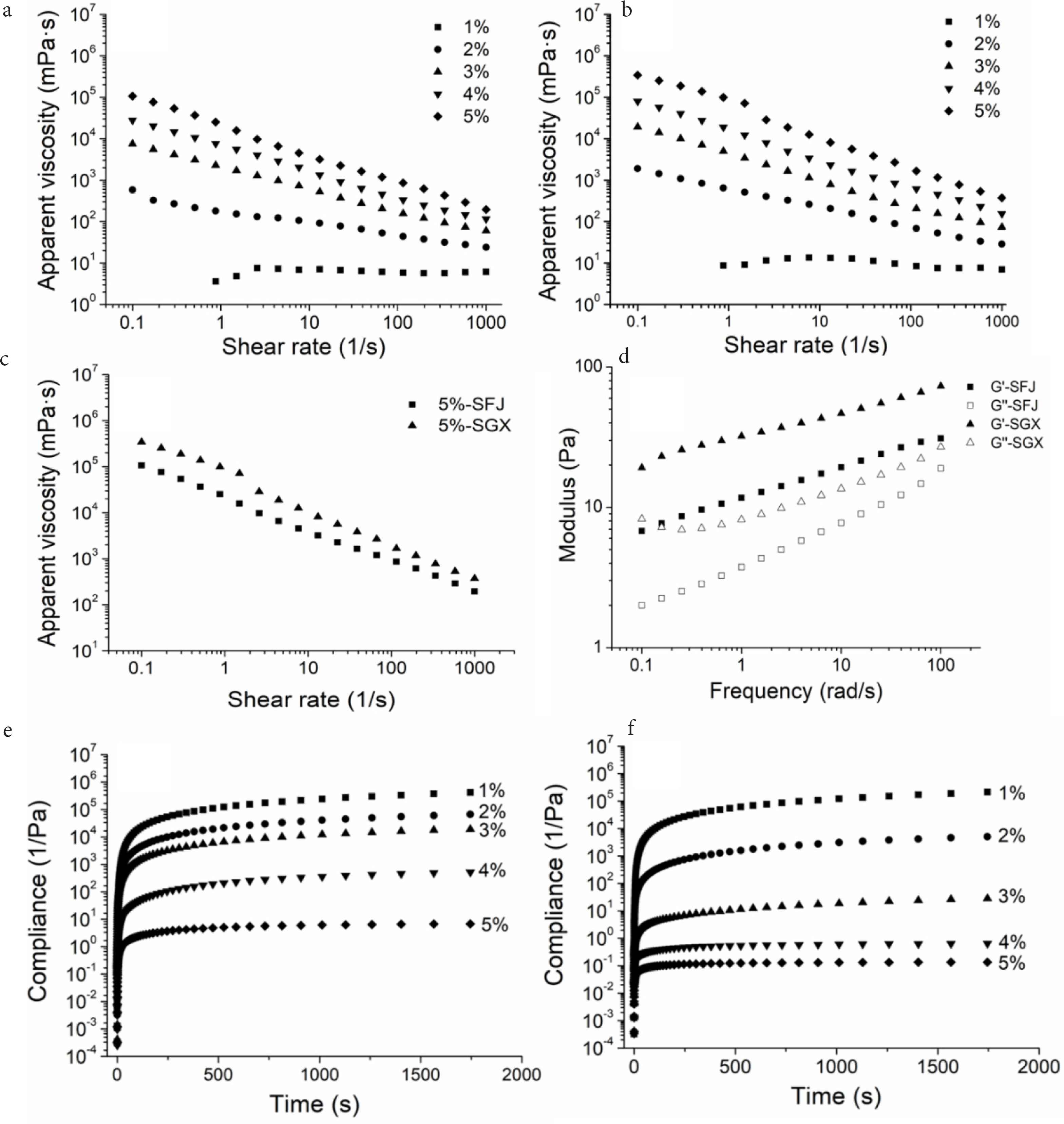
Rheological properties of SFJ and SGX from P. erosus. (a) Apparent viscosity of SFJ under different concentrations; (b) apparent viscosity of SFJ under different concentrations; (c) comparison of shear rate curves of 5% (w/v) SFJ and SGX; (d) storage modulus and loss modulus of 5% (w/v) SFJ and SGX by frequency sweep experiment; (e) and (f) creep curves of SFJ SGX under different concentrations, respectively.
3.3.2. Dynamic rheological properties
The storage modulus (G′) and loss modulus (G″) for 5% (w/v) SFJ and SGX at 25°C and a strain of 2.0% were presented in Figure 5d. The magnitudes of G′ and G″ were frequency dependent and there was no crossover between these two moduli throughout 0.1–100 rad s−1. In addition, the magnitudes of G′ and G″ increased with the increasing angular frequency and G′ value was always much higher than G″ value. These results suggested that both samples probably showed a typically rheological behavior of weak gels [36]. Apparently, both moduli of SGX were much higher than those of SFJ. Therefore, the SGX gel tended to have stronger gel strength than SFJ.
3.3.3. Creep experiment
The creep curves of SFJ and SGX at concentrations of 1–5% (w/v) were presented in Figure 5. In the creep experiment, a constant stress (0.8 Pa) was applied to the sample and the compliance was monitored over time. Generally, a non-linear response to stress indicated normal behavior of viscoelastic materials that combined both elastic and viscous components [24]. The compliance value is an indicator of strength of gels. A low compliance value corresponded to a strong system with low deformability, whereas a high compliance corresponded to a weak system with high deformability [24]. All creeping curves of SFJ and SGX rapidly reached the maximum compliance values, which decreased with the increase of mass concentrations. This result meant that the higher the starch concentration was, the stronger the gel was. By comparing the two starch samples, SFJ exhibited higher compliance values during the creep test at the same concentration. Therefore, the strength of the starch gels of SFJ was weaker than SGX, agreeing with the result of frequency sweep.
3.4. In vitro Digestion Properties
Contents of RDS, SDS, and RS could be indicator of the nutritional value of starch food such as the postprandial glucose and insulin response. Currently, RDS is the major content of most common starches. For example, there were about 70% of RDS in corn starch [37], 96% in barley starch [38], and 76–80% in cassava starch [39]. As displayed in Table 1, SFJ and SGX had extremely high contents of RS (65–70%) and low contents of RDS (11–16%), indicating that SFJ and SGX were resistant to digestion. Similar contents of RS of starches have been reported from Chinese chestnuts (67–85%) [6,40] and naked oat (68–76%) [41]. However, the SDS contents of SFJ and SGX were lower than those from chestnuts (5–20%), but higher than oats (~10%). The hydrolysis rates of SFJ and SGX by porcine pancreatic α-amylase and amyloglucosidase at different time intervals were shown in Figure 6. Different from other starches such as corn starch, the hydrolysis curves of SFJ and SGX did not fit to the first-order equation as described previously [37], which may be attributed to their chemical structures.
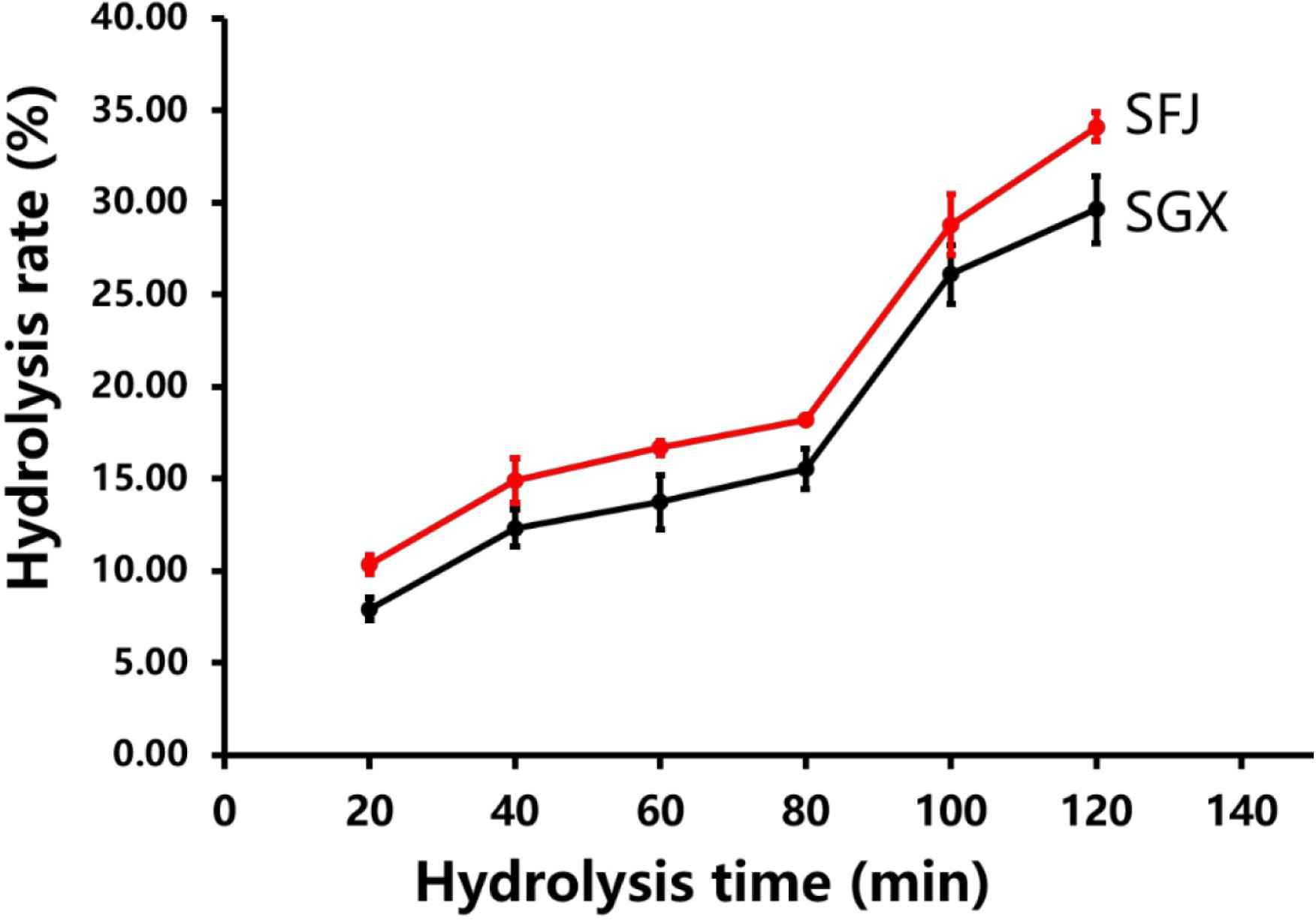
Kinetics of enzymatic hydrolysis of SFJ and SGX from P. erosus.
4. CONCLUSION
In this study, starches (SFJ and SGX) from jicama cultivated in Fujian and Guangxi province in China were extracted, and they presented characteristics of small diameter (3–9 μm) and A-type crystallinity. Thermal and rheological analysis suggested that SFJ had some distinctions in gelatinization temperature, viscosity, starch gel strength, and compliance values with those of SGX, which may be attributed to its smaller granule size and lower crystallinities. For in vitro digestion, both SFJ and SGX had low contents of RDS, relatively low contents of SDS, and high contents of RS. The obtained results in this investigation confirmed that the physicochemical and functional properties of starches might be closely related to the chemical structure of starch. With the increasing demand for novel starch products and resources, jicama starches may be an alternative source of starches to those traditionally used ones. To develop starch from jicama as a new ingredient for industrial applications, more research is required to explore the gelatinization kinetics, retrogradation kinetics, and structure modifications in the future.
CONFLICTS OF INTEREST
The authors declare that they have no conflicts of interest.
AUTHORS’ CONTRIBUTION
XDS contributed in conceptualization, formal analysis, investigation, writing-original draft, software. JJH contributed in resources, investigation, formal analysis. JZH contributed in conceptualization, visualization, writing-review & editing. SYW contributed in conceptualization, supervision, visualization, writing-review & editing, validation.
ACKNOWLEDGMENTS
This work was supported by Natural Science Foundation of China (U1905202) and Fuzhou University Testing Fund of Precious Apparatus (2021T016).
Footnotes
REFERENCES
Cite this article
TY - JOUR AU - Xiao-Dan Shi AU - Jing-Jing Huang AU - Jin-Zhi Han AU - Shao-Yun Wang PY - 2021 DA - 2021/07/09 TI - Physicochemical and Functional Properties of Starches from Pachyrhizus erosus with Low Digestibility JO - eFood SP - 154 EP - 161 VL - 2 IS - 3 SN - 2666-3066 UR - https://doi.org/10.2991/efood.k.210626.001 DO - 10.2991/efood.k.210626.001 ID - Shi2021 ER -
